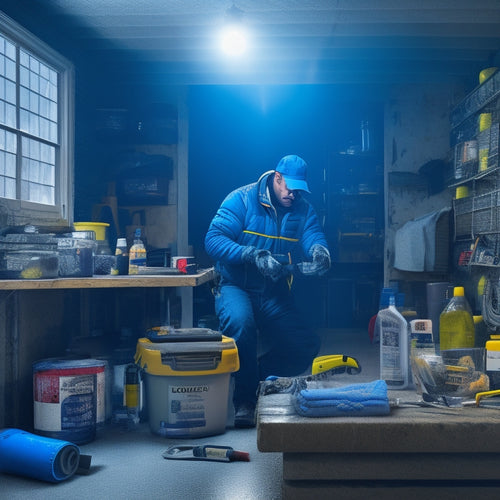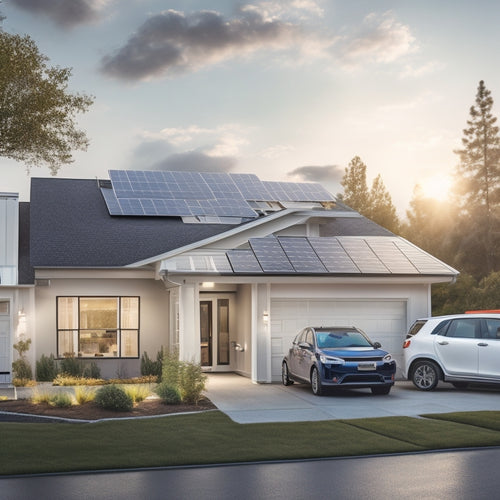
What Does Home Panel System Maintenance Cost?
Share
You can expect to pay between $500 to $1,500 annually for home panel system maintenance. Factors like system size, equipment quality, and maintenance frequency influence this cost. Routine inspection and cleaning are important to prevent electrical issues and guarantee smooth operation. Repairing or replacing parts, inverter replacement, and battery maintenance also impact costs. Professional maintenance visits and monitoring system checks can provide peace of mind, while DIY maintenance can help you save. To get a better grasp on the specifics and optimize your maintenance strategy, explore the various factors that affect your home panel system's maintenance cost.
Key Takeaways
• Average annual maintenance cost ranges from $500 to $1,500, depending on system size, equipment quality, and maintenance frequency.
• Routine inspection and cleaning are crucial to prevent electrical issues and ensure smooth operation, with costs depending on complexity and frequency.
• Repairing or replacing parts can vary in cost, depending on the type and quality of components, with efficient inverters minimizing power outages and boosting energy production.
• Monitoring system checks cost between $100 to $500 per year, covering professional review of system performance and real-time tracking.
• Professional maintenance visits by certified technicians can prevent minor issues from becoming major problems, with costs depending on visit frequency and system complexity.
Average Annual Maintenance Cost
You can expect to pay an average of $500 to $1,500 per year for home panel system maintenance, depending on the size and complexity of your system. This cost allocation may seem challenging, but with some budget planning, you'll be well-prepared to tackle any unexpected expenses.
Think of it this way: your home panel system is like a car – it needs regular tune-ups to run efficiently. And just as you wouldn't neglect your car's oil changes, you shouldn't neglect your panel system's maintenance. In fact, regular maintenance can help prevent costly repairs down the line.
When allocating your budget, consider the size of your system, the quality of your equipment, and the frequency of maintenance checks. A larger system or one with more complex components will naturally require more upkeep, driving up costs. By understanding these factors, you can create a realistic budget and avoid any financial shocks.
Routine Inspection and Cleaning
When maintaining your home panel system, you'll need to perform routine inspections to identify potential issues before they escalate into costly problems.
During these inspections, you'll visually examine the system to identify signs of wear, damage, or debris accumulation.
Visual Examination Process
During routine inspections, a thorough visual examination of the home panel system is crucial to identify potential issues before they escalate into costly problems. As you inspect your panel, you're checking for signs of wear and tear that could lead to electrical issues or even fires.
Here are some key areas to focus on during your visual examination:
-
Panel Condition: Look for signs of rust, corrosion, or water damage that could compromise the integrity of your panel.
-
Wiring Integrity: Check for frayed or damaged wires, loose connections, or overheated components that could cause a short circuit.
-
Terminal Condition: Inspect terminal blocks and connectors for signs of wear, overheating, or corrosion.
- Labeling and Organization: Verify that all components are properly labeled and organized to ensure easy identification and maintenance.
Debris Removal Methods
Regular cleaning of the home panel system is essential to remove debris that can cause electrical issues, overheating, or even fires, and it starts with a systematic approach to debris removal.
You'll want to begin by clearing leaves, twigs, and other obstructions from your gutters and downspouts. Yes, it's a dirty job, but someone's gotta do it! Gutter cleaning is an important step in preventing water damage and making sure your system operates efficiently.
Next, it's time to sweep those roofs! Roof sweeping is an essential part of debris removal, as it helps prevent debris accumulation and reduces the risk of electrical issues. Don't forget to inspect your roof's surface for loose debris, such as branches or leaves, and clear them out.
By doing so, you'll ensure your home panel system operates smoothly and efficiently. Remember, a clean system is a happy system!
Repairing or Replacing Parts
When you're dealing with a malfunctioning home panel system, you'll need to identify the faulty parts and determine whether they can be repaired or need to be replaced.
This diagnosis will help you pinpoint the root cause of the issue and estimate the costs involved in fixing or swapping out the components.
Part Failure Diagnosis
You'll need to identify the root cause of the issue by diagnosing which part of your home panel system has failed, and then decide whether to repair or replace the faulty component. This is where part failure diagnosis comes in. It's like being a detective, searching for clues to solve the mystery of the malfunctioning system.
To diagnose the issue, you'll need to employ various techniques, including:
-
Error code analysis: Deciphering the cryptic messages your system is sending to pinpoint the problem.
-
Fault detection: Identifying the specific component that's gone rogue.
-
Circuit analysis: Examining the electrical pathways to find the source of the issue.
- System log review: Scouring the system's records to uncover patterns or anomalies that might indicate the problem.
Component Replacement Costs
After identifying the faulty component, you must calculate the component replacement costs, which can vary greatly depending on the type and quality of the part, as well as the labor costs associated with the repair or replacement. The cost of replacement parts can range from a few dollars for a simple fuse to several hundred dollars for a complex inverter.
Here's a breakdown of estimated component replacement costs:
| Component | Estimated Cost |
| Inverter | $500 - $2,000 |
| Charge Controller | $100 - $500 |
| Fuses or Breakers | $10 - $50 |
| Wiring or Connectors | $50 - $200 |
When replacing components, consider warranty options to extend the lifespan of your system. An extended warranty can provide peace of mind and protect your investment. Additionally, opting for high-quality replacement parts can lead to an extended lifespan of your system, reducing the need for frequent repairs. By factoring in these costs, you can guarantee your home panel system operates efficiently and effectively.
Inverter Replacement Cost Factors
Your inverter replacement cost will depend on several factors, including the type and quality of the new inverter, labor costs, and any additional upgrades or repairs needed. You'll want to make sure the new inverter is efficient and reliable to minimize the risk of power outages and reduced energy production.
Here are some key factors to take into account:
-
Inverter efficiency: A more efficient inverter will save you money in the long run, but it may come at a higher upfront cost.
-
Inverter type: String inverters are generally less expensive than microinverters, but may not be as efficient.
-
Labor costs: The cost of hiring a professional to replace your inverter can vary depending on location and expertise.
- Additional repairs or upgrades: If other components of your home panel system need repair or replacement, this will add to the overall cost.
Battery Maintenance and Replacement
As your home panel system's energy storage relies heavily on the performance of its batteries, regular battery maintenance and timely replacement are essential to ensuring a consistent and efficient flow of power. You wouldn't want your system to drain like a smartphone on a long road trip, would you?
To avoid this, you'll need to perform routine checks on your batteries, including monitoring their state of charge, voltage, and temperature. Don't worry, it's not as tedious as it sounds! Many modern systems come with built-in monitoring capabilities, making it easy to keep tabs on your energy storage.
When the time comes to replace your batteries, be sure to explore warranty options and consider recycling your old ones. This not only helps the environment but can also provide a discount on your new batteries.
Monitoring System Checks Cost
Regularly reviewing your monitoring system's performance comes at a cost, which can range from $100 to $500 per year, depending on the system's complexity and the frequency of checks. This cost covers the expense of having a professional review your system's performance and identify potential issues before they become major problems.
Here are some key aspects of monitoring system checks that you should be aware of:
-
Real-time tracking: Your monitoring system should provide real-time tracking of your home panel system's performance, allowing you to identify issues as they arise.
-
Automated alerts: With automated alerts, you'll receive notifications when your system is malfunctioning, ensuring you can take prompt action to resolve the issue.
-
System optimization: Regular checks help optimize your system's performance, ensuring you're getting the most out of your home panel system.
- Preventative maintenance: By identifying potential issues early, you can prevent costly repairs and replacements down the line.
Professional Maintenance Visits
Professional maintenance visits from certified technicians can identify and address potential issues in your home panel system, ensuring peak performance and prolonging its lifespan.
You'll want to schedule these visits regularly to prevent minor issues from becoming major headaches.
During these visits, technicians will inspect your system, perform routine maintenance tasks, and make any necessary repairs.
DIY Maintenance Cost Savings
By taking on some maintenance tasks yourself, you can reduce your reliance on professional visits and cut costs associated with routine upkeep of your home panel system. Not only will you save money, but you'll also develop valuable skills and a sense of accomplishment.
To get started, focus on organizing your tools and equipment, so you can quickly find what you need when you need it.
Here are some DIY tasks to tackle:
-
Inspection and cleaning: Regularly inspect your system and clean any debris or dust that may be affecting performance.
-
Filter replacements: Replace air filters and other filters as needed to ensure peak system performance.
-
Battery maintenance: Check and maintain your battery bank to ensure it's functioning at its best efficiency.
- Monitoring system performance: Keep an eye on your system's performance and address any issues promptly to prevent more costly problems down the line.
Frequently Asked Questions
Can I Perform Maintenance Tasks on My Own Solar Panel System?
You can perform basic maintenance tasks on your own solar panel system, ensuring energy efficiency and system reliability, but don't get too comfortable, as improper DIY fixes can void your warranty or spark safety issues.
How Often Should I Inspect My Home's Electrical Panel System?
You should inspect your home's electrical panel system every 6-12 months to validate panel reliability, performing safety checks to prevent electrical surges, circuit overloads, and maintaining system efficiency through regular upkeep.
What Tools Do I Need for DIY Maintenance and Repairs?
You'll need a well-stocked toolbox with essentials like voltage testers, wire strippers, and pliers to tackle DIY maintenance and repairs. Don't forget to prioritize safety protocols, like insulated gloves and a first-aid kit, to avoid electrical shocks and other hazards.
Are Maintenance Costs Covered Under My Home Warranty?
You're wondering if your home warranty covers maintenance costs, right? Check your policy for Warranty Exclusions and Policy Limitations to avoid surprises; don't assume everything is covered, or you might be stuck with a hefty bill!
Can I Claim Maintenance Costs on My Taxes as a Homeowner?
As a homeowner, you're wondering if you can claim maintenance costs on your taxes. Good news! You might be eligible for a tax credit or filing deductions, so keep those receipts handy and consult a tax pro to maximize your savings.
Related Posts
-

Waterproofing Solar Panels for Vehicles: A Step-by-Step Guide
When waterproofing solar panels for your vehicle, start by evaluating your energy requirements and selecting the righ...
-

What Electric Vehicle Owners Need for Home Energy
As an electric vehicle owner, you need to optimize your home energy system to guarantee efficient, sustainable, and c...
-

Why Go Green With Automotive Products Online?
By switching to eco-friendly automotive products online, you're taking a significant step towards reducing your carbo...


